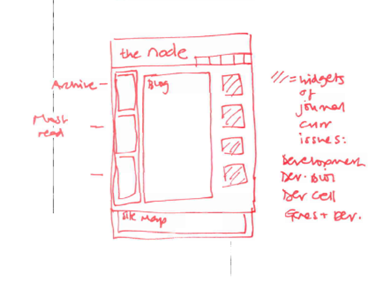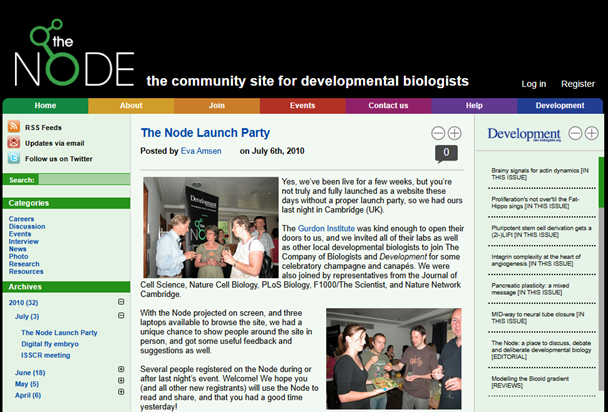How to build a community site for developmental biologists
Posted by Joyce Yu, on 24 March 2025
2025 is the 100th birthday of The Company of Biologists, our not-for-profit publisher. Another birthday this year, albeit celebrating a much smaller number, is the Node’s 15th! If we take the time machine back to 2010, one of the events that happened in our little corner of the world was the launch of the Node. In June that year, Development and The Company of Biologists brought the first ever online developmental biology community site to life.
What did it take to build a community site from scratch? What even is a community site? Follow along to find out how the Node was born.
Step 1) Set the scope.
The idea of a ‘community blog’ started in late 2008, when Development surveyed members of the developmental biology community about the journal’s strengths and weaknesses. Although the survey did not explicitly ask about the journal’s website, many comments were along the lines of wanting ‘a more personal and interactive experience’ online. We called Development a community journal, and according to the survey, people wanted us to be just that: an online community for people to interact, gossip, share events and job openings, and write about research advances and all kinds of research-adjacent issues – somewhere that would be a one-stop-shop for developmental biologists.
While the community site would be hosted by Development, we didn’t want to limit the blog’s content to our journal, as we wanted to place ourselves as THE site for all developmental biologists – featuring research published in a wide range of journals and providing a forum for conference organisers, societies and other relevant organisations worldwide to reach out to the community. From the beginning, the idea was that anyone with an interest in developmental biology could post on and interact with the site.
Step 2) Set aside the budget and get the Board’s approval.
It wasn’t difficult to convince the Board to approve the proposal of setting up a community site. According to the Board meeting minutes, “it was unanimously agreed that Development should appoint an Online Editor to run their community website.” At its inception the Node was backed by a 3-year budget, which was a relatively long time for a digital ‘experiment’. The budget included the design work of the logo and the website, creation of webpages, and a lot of background coding work. Interestingly, the initial budget included ‘podcasts’, but that idea was quickly shelved.
Step 3) Pick a name for the site.
Do you know the Node could have been called ‘Out on a limb’? It is unclear how seriously this name was considered, but the name was mentioned in one of the brainstorming documents from 2009.
Eventually, ‘the Node’ came up in an email titled ‘Eureka!’ sent from Development’s then Executive Editor Jane Alfred to The Company of Biologists’ publisher Claire Moulton – two important people behind the inception of the Node – and the blog finally had a name!
“The Node felt like the perfect name for a community website that was aiming to be a hub of information and knowledge exchange for developmental biologists. It’s also a term that many development biologists will be very familiar with given that the node in developing embryos is a vitally important tissue that organises and orchestrates vertebrate development.” — Jane Alfred
Step 4) Hire a Community Manager.
Jane and Claire wanted to find someone with experience in blogging and online community building to help set up and run the site. In early 2010, Eva Amsen joined the Node as its first Community Manager.
In this conversation with the past and present Community Managers, Eva recounts how she applied to a different role within the Company but was then invited to apply to the Node position. Because Jane and Claire didn’t want to give away too much in the job advert, Eva wasn’t told what the job was really about until the interview!
Initially, we thought that once we got the momentum going, the Node would be able to run itself, without requiring the day-to-day management and commissioning of content from the Community Manager. But 15 years on, the fact that I (the current Community Manager) am writing this piece, suggests a more hands-on approach is required to keep the site running. As there’s a constant flow of new people coming into the field, it’s useful to have someone promoting the Node to new generations of developmental biologists.
Step 5) Design the homepage.
To be the one-stop-shop for the developmental biology community, and more than just a blog, it was important to include features like jobs board, events calendar and resources (listing related societies, databases, and journals).
A freelancer was hired to set up the website and some in-house resource was available to ensure the continued smooth running of the site. Over the years, the website became more professionalised when we formed a long-term partnership with a technology consultancy – something that has proved central to our ability to grow and develop the site.

Step 6) Write the policies and T&Cs.
A very important, but admittedly not as exciting piece of work was to set out the general guidelines, commenting policy, privacy policy and the Terms and Conditions. The team studied other similar science and journal blogs (there weren’t that many at that time) and came up with a set of guidelines to ensure the platform is inclusive and that discussions are carried out in an appropriate tone. One thing we worried a lot about was whether some of the topics we were likely to feature on the site might attract negative attention from, for example, anti-abortionists or creationists. While the Node is aimed at a scientific audience, we needed to have policies in place to ensure that we could handle controversial or inappropriate content should it arise. Fortunately, this hasn’t been an issue for us and in 15 years of the Node, we’ve only had to moderate its content on a handful of occasions.
Step 7) Populate the site with posts.
An empty community site would not feel very community-like. In order to make sure there was already something interesting for people to read when the Node was launched, Eva Amsen, the first Community Manager, was tasked with populating the site with content in the months leading up to the launch. That’s why even though the Node was officially launched in June, you can find posts dating back to April 2010. Curious to find out what the early posts were about? You can go down the memory lane using our (new-ish) improved search function by filtering according to the year and month.
Step 8) Organise a launch party!
After months of hard work, what better way to launch the Node than to have a party? The launch party was held at the Gurdon Institute, Cambridge, where people from the institute and developmental biologists in the area could have a browse around the Node and sign up an account on the spot.
15 years on, the (online) world has changed drastically, but the Node hopes to stick around, serving the developmental and stem cell biology community for years to come. Please continue to read and contribute to the Node – the Node wouldn’t have lasted for 15 years without your support!

Further reading
A conversation with the Node Community Managers, past and present
Vicente C, Maartens A, Brown K. The Node and beyond-using social media in cell and developmental biology. Semin Cell Dev Biol. 2017;70:90-97. doi:10.1016/j.semcdb.2017.05.009 – published as part of the special issue “Science communication in the field of fundamental biomedical research”



 (No Ratings Yet)
(No Ratings Yet)